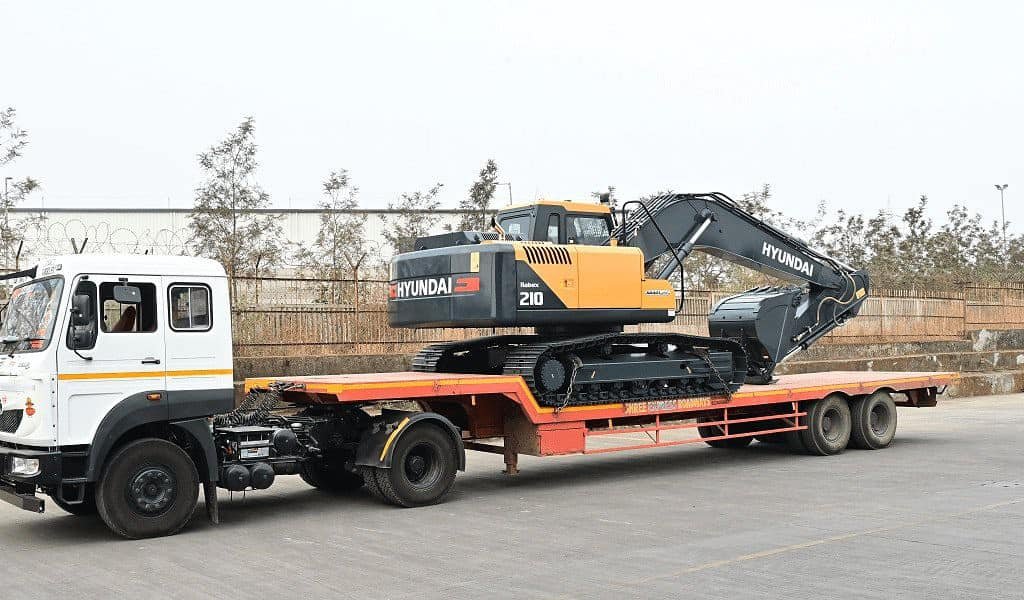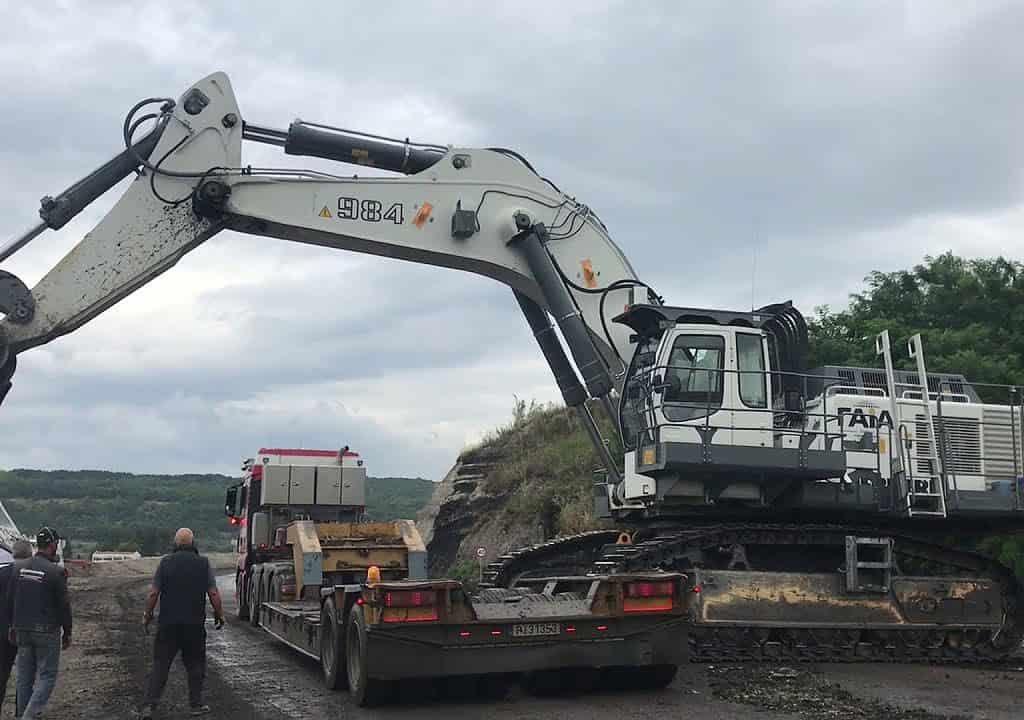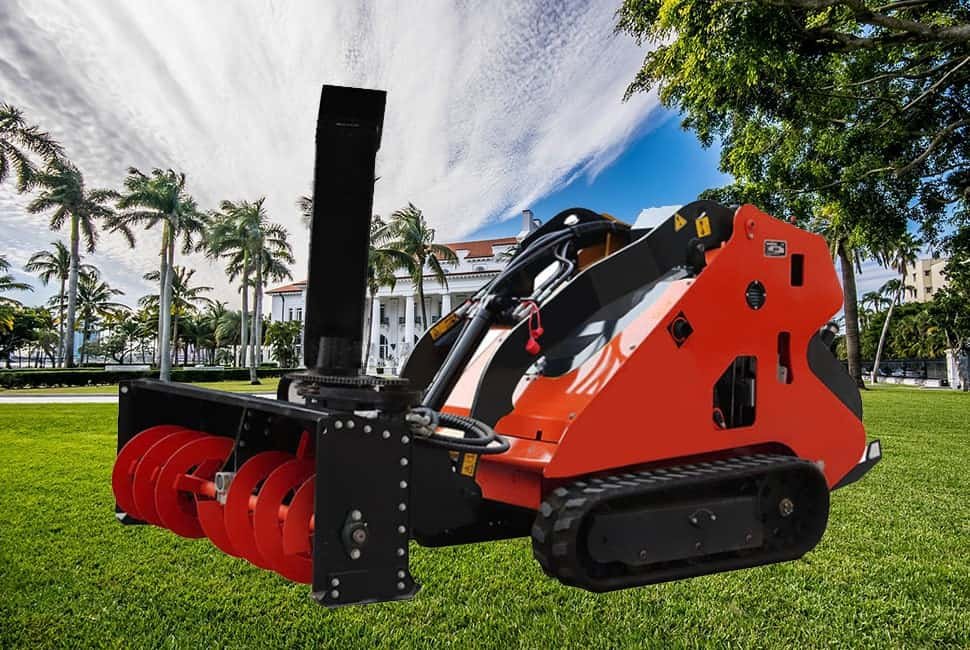Choosing the wrong trailer for transporting excavators can lead to damage, delays, or accidents. Here’s how to pick the right trailer for safe and efficient transportation.
To choose the right trailer for transporting an excavator, consider the machine’s weight, dimensions, and transportation distance. Match these factors with the trailer’s load capacity, design, and features to ensure safe and efficient transport.
Selecting the ideal trailer is just one part of the process. Let’s dive deeper into the steps and considerations for moving excavators securely.
How Do You Transporting Excavators?
Transporting an excavator is a complex task that requires meticulous planning and careful execution to guarantee the safety of both the machinery and the personnel involved. It’s crucial to follow a series of well-defined steps to ensure a smooth and secure journey.
The process begins with the selection of an appropriate trailer that is specifically designed to accommodate the size and weight of your excavator. This choice is pivotal as it directly impacts the stability and safety of the transport. Once the right trailer is chosen, the next step is the careful loading of the excavator, which can be facilitated by using ramps or loading docks that provide a stable and controlled ascent into the trailer. After the excavator is safely on the trailer, it’s essential to secure it with robust tie-down chains or straps to prevent any movement during transit, which could lead to accidents or damage.

Adherence to transportation laws is also a critical component of the process. This includes being aware of and complying with local regulations regarding trailer load limits, which can vary by region, and ensuring that all licensing requirements are met. By following these guidelines, you can help ensure that your excavator arrives at its destination without incident, protecting both your investment and the safety of those around you.
How Much Does an Excavator Weigh in Ton?
Understanding the weight of your excavator is an essential first step in selecting the appropriate trailer for transportation. This knowledge is vital for ensuring the safety and stability of the transport process.
Excavators come in a wide range of sizes and weights, typically ranging from 1 to 100 tons. On one end of the spectrum, you have mini excavators, which are relatively lightweight and usually weigh between 1 to 6 tons. At the other end, there are the colossal excavators that can weigh over 80 tons, requiring specialized transportation solutions.
To illustrate, if you have a 5-ton excavator, it’s important to select a trailer with a capacity of at least 6 tons. This additional capacity is necessary to accommodate the weight of any attachments, such as buckets, attachments, or counterweights, which can significantly increase the total load. It’s also crucial to consult the manufacturer’s specifications for the exact weight of your excavator, as these can vary even within the same model due to different configurations or modifications. By doing so, you can ensure that the trailer you choose is not only capable of handling the excavator’s weight but also complies with all safety standards and legal requirements.
What Is the Best Way to Haul an Excavator?
Efficiently hauling an excavator demands not only the right equipment but also a commitment to safety practices that protect both the machinery and the personnel involved in the transportation process.
For smaller and medium-sized excavators, flatbed or lowboy trailers are typically the most suitable choices. Flatbed trailers are perfect for shorter distances, offering a straightforward and accessible platform for loading and unloading. They provide a stable surface that allows for easy access to the excavator, making them a popular choice for local transport jobs.
On the other hand, lowboy trailers are designed to handle taller equipment by lowering the overall height of the load. This feature is particularly useful when navigating underpasses and bridges where height restrictions are a concern. Lowboy trailers are also equipped with the necessary ramps and equipment to safely load and secure taller excavators, ensuring a smooth transport experience.

When it comes to heavy-duty hauling, especially for larger excavators, goose-neck trailers are often the preferred option. These trailers provide added stability due to their unique design, which lowers the center of gravity of the load. This increased stability is crucial for long-distance transport and for loads that are particularly heavy or unwieldy.
In addition to selecting the appropriate trailer, it’s essential to consider road conditions and route restrictions when planning your transport. Factors such as road width, weight limits, and permit requirements can significantly impact your transport strategy. By taking these into account, you can ensure that your transport route is not only the most efficient but also the safest and most compliant with local regulations.
How Do They Transport Giant Excavators?
Giant excavators, due to their substantial size and weight, necessitate specialized transport methods that are tailored to handle such colossal machinery.
For these behemoths of the construction world, standard trailers simply won’t suffice. Instead, oversized trailers are employed, which are often equipped with multiple axles and additional support structures. These trailers are designed to distribute the immense weight of the excavator evenly, ensuring stability during transport. Their robust construction and engineering are crucial for accommodating the unique challenges posed by transporting such large-scale equipment.
Transporting giant excavators often involves a strategic disassembly process. Parts like the booms or tracks, which contribute significantly to the overall dimensions of the excavator, are typically detached to reduce the size of the load. This allows for more manageable transportation and helps to navigate the excavator through tight spaces or under height restrictions that would otherwise be impossible with the machine in its fully assembled state.

Escort vehicles are a common sight when oversized loads are on the move. These vehicles are essential for guiding and safeguarding the transport of giant excavators through highways. They help to manage traffic, alert other drivers to the presence of the oversized load, and ensure that the transport can proceed safely and smoothly. Additionally, adhering to weight distribution laws is paramount. These regulations are in place to prevent overloading and to ensure that the weight of the excavator and its components are evenly distributed across the trailer. Compliance with these laws not only ensures a safe transport but also helps to prevent damage to the road infrastructure and potential accidents.
How Do You Move a Non-Running Excavator?
Transporting a non-running excavator presents unique challenges that require specific tools and techniques to overcome effectively.
In the absence of a functioning excavator, specialized equipment such as winches, skids, or cranes becomes indispensable for loading the machine onto a trailer. These tools are designed to handle the weight and size of the excavator safely and efficiently. When employing a winch, for instance, it’s crucial to use it in conjunction with ramps to gently pull the excavator onto the trailer, minimizing the risk of damage. Skids can also be used to slide the excavator into place, providing a stable and controlled method of loading.
Once the excavator is in position on the trailer, it’s imperative to ensure that all parts are securely fastened to prevent any movement during transport. This step is critical, as it safeguards both the equipment and anyone involved in the transportation process. Tie-downs, chains, or straps should be used to firmly secure the excavator, and each point of attachment should be double-checked for stability and safety.
In cases where the excavator is completely immobile or the situation is particularly complex, cranes or forklifts may be necessary to lift and place the machine onto the trailer. These heavy-duty machines offer the lifting capacity required for such tasks but must be operated by trained personnel to avoid accidents. Throughout this process, it’s essential to conduct thorough inspections of the equipment. This includes checking the excavator for any pre-existing damage and ensuring that all lifting points and securing methods are in good condition. By doing so, you can minimize the risk of further damage and ensure a safe and successful transport.
How Do You Pack an Excavator?
Properly packing an excavator for transport is a meticulous process that demands precision to ensure the safety and integrity of the equipment during transit.
To begin, it’s essential to prepare the excavator for loading. This includes lowering the boom to its lowest position and locking the tracks to prevent any unintended movement. These actions help to minimize the excavator’s profile and make it more stable for transportation. Next, secure the excavator to the trailer using heavy-duty chains or straps, which are designed to withstand the substantial weight and potential shifts during transit. These restraints are crucial in preventing the excavator from moving or tipping, which could lead to accidents or damage.
The positioning of the excavator on the trailer is another critical aspect of the packing process. It’s important to align the excavator’s center of gravity correctly to maintain balance and stability throughout the journey. This often involves adjusting the excavator’s position on the trailer until it sits evenly, with weight distribution that prevents any tilt or wobble. If the excavator has attachments, such as buckets or hydraulic hammers, these should be secured separately to ensure they do not become loose or cause additional imbalance.

Before the transport begins, a thorough check of all restraints is mandatory. This includes inspecting every chain, strap, and locking mechanism to ensure there’s no looseness or potential failure points. A secure and well-checked excavator is not only safer for transport but also less likely to cause damage to itself or other vehicles on the road. By taking the time to double-check each restraint, you can help ensure a smooth and incident-free journey for your valuable equipment.
How Do You Offload an Excavator?
The process of offloading an excavator demands the same level of precision and caution as loading it, to prevent accidents and ensure the safety of all involved.
Firstly, it’s crucial to align the trailer with a stable unloading area that provides a solid, flat surface for the excavator to be safely lowered onto. The use of ramps is essential during this phase; they allow for a controlled descent of the excavator as it is carefully reversed down from the trailer. Throughout this operation, maintaining the excavator’s balance is paramount to prevent any tipping or instability that could lead to accidents.

Before commencing the offloading process, it’s imperative to ensure that the unloading site is level and clear of any debris that could pose a hazard. Uneven surfaces or obstacles can cause the excavator to become unstable or lead to damage during the offloading process. Operating the excavator in a controlled manner is also key; this includes keeping the bucket or blade low to the ground, which not only enhances the stability of the machine but also reduces the risk of it swinging out of control.
Lastly, it’s always advisable to have an observer on hand to guide the process. This person can help monitor the excavator’s movements, communicate with the operator, and alert them to any potential hazards in the vicinity. Their role is crucial in coordinating the offloading process and ensuring that it proceeds smoothly and safely.
How Much Diesel Does an Excavator Use Per Hour?
Fuel efficiency plays a pivotal role in determining the overall transport costs associated with operating an excavator.
Excavators, much like other heavy machinery, have varying fuel consumption rates that are influenced by their size and the intensity of their workload. On average, these machines can consume anywhere from 6 to 14 liters of diesel per hour. This range reflects the differences in fuel usage between smaller, more compact models and larger, more powerful excavators that tackle more demanding tasks.
To illustrate, a 5-ton excavator, which is considered a mid-sized machine, might use approximately 7 liters of diesel per hour during normal operation. However, it’s important to consider that this figure can fluctuate based on the specific conditions of the job. Idle time, when the engine is running but the excavator is not actively working, also contributes to fuel consumption. Therefore, when estimating the overall fuel consumption for a transport job, it’s crucial to take into account both the active working time and any periods of idleness.
By optimizing transport routes to minimize travel time and avoiding unnecessary detours, operators can significantly reduce fuel costs. This not only benefits the bottom line but also contributes to more sustainable operations. Strategic planning and efficient route selection are key to managing fuel consumption effectively, especially for large-scale projects where transport costs can quickly escalate.
What Is the Maximum Weight I Can Tow?
Understanding the towing limits for an excavator is crucial and is influenced by a combination of local regulations, the capacity of the trailer, and the specifications of the towing vehicle.
Trailers are designed with specific gross weight limits in mind, which encompass not only the weight of the excavator itself but also the weight of the trailer and any additional accessories or equipment that may be carried. These limits are critical safety parameters that must be respected to ensure the stability and safety of the towing operation.
For example, a standard commercial towing vehicle might be legally permitted to tow a load of up to 40 tons. However, it’s important to note that this maximum towing capacity can vary significantly from one region to another due to differences in local laws and regulations. It’s also essential to recognize that the towing vehicle’s own weight and the weight of any additional equipment must be subtracted from this total to determine the actual allowable weight for the excavator.
Always take the time to verify the load rating specified by the trailer manufacturer and cross-check this with the towing vehicle’s capabilities to ensure that the total weight being towed is within safe limits. This includes considering the weight of the excavator, the trailer, any attachments, and the potential for additional loads. Ensuring that the towing vehicle can handle the total weight safely is not just a matter of compliance with the law, but also a fundamental aspect of preventing accidents and ensuring the secure transport of valuable equipment.
Do Excavators Tip Over?
Tipping over is a significant hazard that can occur during both the transportation and operation of excavators, posing a serious risk to equipment and personnel.
Several factors can contribute to this danger, including improper loading techniques, uneven weight distribution across the excavator, and taking sharp turns at high speeds. To mitigate these risks, it’s essential to adhere to best practices that prioritize stability and safety. These practices include ensuring that the excavator is loaded correctly onto the trailer, with the weight evenly distributed to maintain balance. This might involve adjusting the position of the excavator on the trailer until it sits squarely, with no tip towards one side.
During transportation, it’s crucial to avoid high-speed travel on roads that are uneven or poorly maintained, as the jolts and vibrations can disrupt the excavator’s balance. Driving at a moderate speed and taking turns smoothly can significantly reduce the likelihood of a tip-over incident. Additionally, always ensure that the weight is evenly distributed across the trailer to prevent any shifts that could lead to instability.
When operating the excavator in environments that pose an increased risk of tipping, such as on slopes or uneven terrain, the use of outriggers or stabilizers is highly recommended. These devices help to anchor the excavator securely to the ground, providing additional support and reducing the risk of tipping. They are particularly important when the excavator is lifting heavy loads or performing tasks that require it to be positioned at an angle.
By following these guidelines and taking a cautious approach to both transportation and operation, the risks associated with tipping can be significantly reduced, ensuring the safety of the equipment and those working around it.
ISO and SAE Standards: What Do They Mean?
These standards play a crucial role in ensuring equipment safety and compatibility.
Snippets Paragraph
ISO and SAE define dimensions, safety features, and operating guidelines for excavators and their transport.
Related Content
For instance, ISO 9001 ensures quality management, while SAE J743 specifies hydraulic power standards. Familiarity with these ensures compliance during transport and operation.
International standards organizations such as the International Organization for Standardization (ISO) and the Society of Automotive Engineers (SAE) play a significant role in defining the critical dimensions, safety features, and operating guidelines for excavators and their associated transport equipment. These standards are designed to promote uniformity across the industry, ensuring that equipment from different manufacturers can work together seamlessly and safely.
For example, ISO 9001 is a widely recognized standard that focuses on quality management systems. It ensures that organizations have a robust framework for quality assurance, which is particularly important during the manufacturing and servicing of excavators. This standard helps to guarantee that the excavators produced meet high-quality standards, reducing the risk of故障 and ensuring reliability.
On the other hand, SAE J743 is a specification that deals with hydraulic power standards for mobile equipment, including excavators. It defines the performance criteria and testing procedures for hydraulic systems, which are crucial for the operation of excavators. Compliance with this standard ensures that the hydraulic systems in excavators are designed and maintained to perform efficiently and safely.
Familiarity with these and other relevant standards is essential for operators, manufacturers, and transporters of excavators. It ensures that all parties are in compliance with the regulations, which is crucial for the safe and efficient transport and operation of these heavy machines. By following these standards, the industry can reduce the risk of accidents, improve equipment interoperability, and maintain a high level of performance across all operations.
Résumé
Choosing the right trailer involves understanding your excavator’s specifications, transport regulations, and route conditions. Follow these tips to ensure a smooth and safe process.


